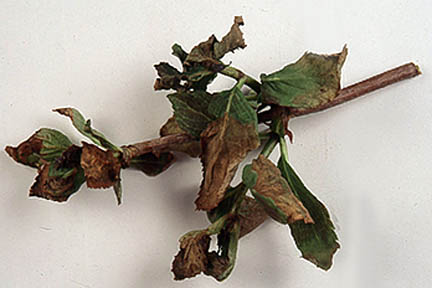
Quick facts
Common name - Brown leaves on woody plants
Plants affected - All climbers, trees and shrubs
Main causes - Weather conditions
Timing - All year
Why do leaves turn brown?
Plants can be harmed by many problems, including feeding damage from invertebrates or mammals, attack by diseases, and issues caused by adverse environmental factors. However, they can only respond in a limited number of ways, and developing brown leaves is the most common. As a result, figuring out what has caused leaf browning is an essential first step in protecting your plants.
Symptoms
Leaves can turn brown in three ways:
- Leaves can go partially brown – on the edges and tips; within the leaf; and, often, along the central vein.
- Browning can occur over whole leaves; on the top or the outside of the plant’s foliage; and within the plant’s canopy.
- Whole shoots or plants can go brown. This often suggests that the roots, stems and trunk (one or more) are the location where damage has occurred.
Part-leaf browning
These are causes for browning across part of the leaf, and the controls.
Brown leaf tips or margins
Cause
Brown tips or margins often indicate drought in spring or summer. Young growth is particularly susceptible. It may also indicate establishment failure. This is particularly common where dry weather follows spring planting, prior to new roots developing into the surrounding soil.
The damage is often worse where exposure to wind dries out the leaves. The damage is usually worse on the windward side of the plant. In coastal areas, salt-laden winds can also be especially harmful, but this is due to the effect of the salt as well as drying.
Control
- Keep young plants well watered while they establish. This can take from three months to three years, depending on the plant, site and conditions
- Provide shelter from the wind by using a length of shelter fabric (available at garden centres); planting a hedge or shrubs to give protection
- Grow plants that are suited to coastal positions
Blackening within leaves
Cause
The blackening of leaves, usually starting along the vein, is due to water-logging. This is common after wet winters on heavy soils and is frequently seen on Aucuba (spotted laurel) as a problem known as aucuba blackening. The roots, when examined, are a bluish-black and fall apart when teased apart. On larger roots the outer sheath may pull away easily, leaving the inner core. There is often a sour smell to both the soil and roots.
Similar leaf symptoms can sometimes be caused by certain foliar diseases, including the notifiable pathogen Phytophthora ramorum.
Control
- Where waterlogging is a permanent problem, consider installing a drainage system
- Grow plants that thrive in wet soils
- Use raised beds to lift the roots clear of the winter watertable
- See our advice on the link above if Phytophthora ramorum is suspected
Whole-leaf browning
These are causes for browning across the entire leaf, with remedial measures.
Brown, desiccated lower leaves
Cause
Brown desiccated lower leaves are common on climbers and this is due to dryness at the roots.
Control
- Regular watering is particularly important for newly-planted stock but, in prolonged dry spells, even may require additional watering
Whole, brown single leaves
Cause
Some leaves go brown from natural causes – evergreen leaves, for example, are long-lived, but are replaced every few years. This often occurs in summer and can be alarming. However, natural replacement is usually confined to lower and older leaves, and those within the foliage or canopy.
Whole brown leaves can also be seen after infection with diseases such as powdery mildew.
Control
- If the powdery stage is missed, it is not always obvious that the original cause was disease. Remove affected leaves and a keep close watch for future infections
Shoot and plant browning
These are causes for the browning of whole shoots or plants, and the controls.
Entire shoots go brown
Cause
Browning of shoots suggests that something is preventing moisture reaching the affected leaves. Tracing the shoot back to the trunk can sometimes reveal cankers or other damage.
Progressive wilting and browning of shoots can be caused by many diseases, including blossom wilt, apple canker, bacterial canker, coral spot, fireblight or verticillium wilt.
Girdling damage to shoots or branches from the activities of grey squirrels can also lead to dieback. Some trees, such as sycamore, are affected more commonly than others.
Control
- Cankers or other stem and trunk damage should be pruned out, otherwise, the affected shoots will have to be removed
Whole plants go brown
Cause
When whole plants go brown, the cause is usually in the roots or trunk. This is frequently due to poor planting and aftercare; lawnmower or strimmer damage; girdling bark damage on the main stem from the activities of rabbits, grey squirrels, deer or voles; waterlogging; or root disease, most commonly honey fungus or Phytophthora root rot. Root diseases can often be detected by examining the collar (where the trunk goes into the ground) and some of the main roots, checking beneath the bark.
Control
- Ensure that plants are carefully planted and that they are looked after while they establish
- Be careful not to damage plants with mowers or strimmers
- Use rabbit collars or make a pen of chicken wire around the plant to discourage rabbit damage
- Grow in raised beds, mounds or use plants that thrive in conditions






